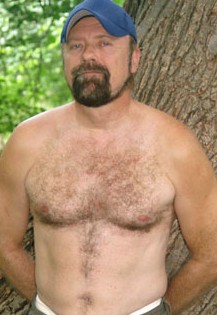
Born that gay
Do recent neurological studies prove once and for all that homosexuality is biological?
By Robert Burton
http://www.salon.com/env/mind_reader/2008/09/12/gay_neurology/index.html
See what you think after reading this latest scientific study about why we are gay.
Sept. 12, 2008 As the accuracy and resolution of brain imaging improve, we can expect virtually all behavior to be shown to be associated with demonstrable brain changes. It shouldn't come as a surprise that imaging studies of sexual orientation are increasingly revealing anatomic and functional differences between "straight" and "gay" brains. But demonstrating such changes doesn't answer the age-old question of how much our sexual preferences are innate and how much they are fueled by environmental exposure, cultural norms and conscious personal choices.
One way to distinguish the effects of nature from nurture would be to look at brain regions believed by neuro-anatomists to be fully formed at birth and impervious to subsequent environmental effects, both physical and psychological. Focusing on such brain regions, a research team at the Karolinska Institute in Stockholm, Sweden, headed by neuroscientist Ivanka Savic, obtained MRIs for 90 adult volunteers -- 25 straight men, 25 straight women, 20 gay men and 20 lesbians. Using the latest quantitative techniques for assessing cerebral symmetry and functional connections between various areas of brain, Savic was able to demonstrate highly statistically significant differences between straight and gay brains. Gay and lesbian brains more closely resembled the brains of straight volunteers of the opposite sex than the brains of heterosexual members of the same sex.
Sept. 12, 2008 As the accuracy and resolution of brain imaging improve, we can expect virtually all behavior to be shown to be associated with demonstrable brain changes. It shouldn't come as a surprise that imaging studies of sexual orientation are increasingly revealing anatomic and functional differences between "straight" and "gay" brains. But demonstrating such changes doesn't answer the age-old question of how much our sexual preferences are innate and how much they are fueled by environmental exposure, cultural norms and conscious personal choices.
One way to distinguish the effects of nature from nurture would be to look at brain regions believed by neuro-anatomists to be fully formed at birth and impervious to subsequent environmental effects, both physical and psychological. Focusing on such brain regions, a research team at the Karolinska Institute in Stockholm, Sweden, headed by neuroscientist Ivanka Savic, obtained MRIs for 90 adult volunteers -- 25 straight men, 25 straight women, 20 gay men and 20 lesbians. Using the latest quantitative techniques for assessing cerebral symmetry and functional connections between various areas of brain, Savic was able to demonstrate highly statistically significant differences between straight and gay brains. Gay and lesbian brains more closely resembled the brains of straight volunteers of the opposite sex than the brains of heterosexual members of the same sex.
In their study, reported in the June 16, 2008, issue of the Proceedings of the National Academy of Sciences, Savic said, "This is the most robust measure so far of cerebral differences between homosexual and heterosexual subjects." Although Savic admits that her study cannot distinguish between genetic or prenatal intrauterine environmental changes, such as relative differences in sex hormone levels, her studies do suggest that our sexual preferences are, at least in large part, determined by the time of birth.
Not long after reading the study, the author got a call from neurologist Jerome Goldstein, M.D., 67, once a fellow resident in the UCSF neurology training program. This fall, Goldstein, an internationally respected headache researcher and sometimes controversial gay activist, is giving a series of lectures on the innate biology of gayness. He was phoning to ask if I had seen the study and if I might write about the latest scientific evidence supporting the biology of gayness. I decided to interview him instead. Goldstein is compact, rapid-talking and constantly on the verge of impatience. Yet during our conversations he was subdued, confessional in tone, with frequent pauses to gather his thoughts; the seriousness of his concerns was palpable.
Jerry, you've been an outspoken gay activist for 40-plus years. Why the sudden interest in the biology of sexual orientation?
I was aware that I was attracted to men by age 8, even though I did not have any gay sexual experiences until I was 19. Meanwhile, despite having no sex or even a clear understanding of what homosexuality meant, virtually everyone that I encountered, including my dear parents, made a point of telling me that homosexuality was dirty, sinful and a phase that would pass.
Beginning my sophomore year in college, and before my first gay experience, I began the endless rounds of psychiatrists and counselors. I even tried to modify my behavior to make it acceptable. Sadly, even though I now know better, and am fully aware of the overwhelming evidence as to the underlying neurobiologic predisposition to gayness, I have never been able to entirely shake this feeling of guilt and wrongdoing. Future generations should be spared. Right now, I'm interested in seeing that good science prevails over outdated, misguided psychology and false-headed thinking that homosexuality is a conscious choice.
Do you think people accept that homosexuality arises out of biological predispositions?
Only on the surface. Down deep, there's a lingering suspicion that, even if the cause is biological, there is something intrinsically wrong with being gay. It has been 35 years since homosexuality was removed from a psychiatric diagnostic category and we [still] don't see the changes in the way people think. Sadly, even our major neurological societies haven't taken a serious look at the biology of sexual orientation. For example, when was the last time that you saw the American Academy of Neurology even address the subject? And the general public? Just listen to right-wing talk show hosts offering to pray for my sins. Or look at the damage caused by the religious right and its "conversion therapy," which attempts to alter an inborn characteristic of human behavior. I don't want pity and sympathy, I want scientific understanding based on logic and reason.
Could you give me a brief rundown of what you think is the most compelling evidence supporting the biology of gayness?
Keep in mind that sexual orientation is exceedingly complex and not reducible to a single gene or hormonal aberration, or explained by demonstrable anatomic brain differences. But by examining multiple lines of evidence, you can begin to connect the dots as to how biology influences sexual preferences. With these caveats in mind, let's look at the history leading up to the present functional imaging studies.
In 1991, Simon LeVay, formerly a professor of neuroscience at Harvard and the Salk Biological Institute, claimed to have discovered specific anatomic differences between gay and straight brains, primarily in a region of the hypothalamus believed to have a major influence on sexual behavior. By the way, this region's fetal development is greatly influenced by the levels of intrauterine testosterone, a major reason why intrauterine shifts of sex hormone levels are thought by some researchers to contribute to sexual preference.
But LeVay's work was considered controversial, nonreproducible, and part of a gay political agenda. The real take-away was the promise that neuroscience might one day offer better insights into the origins of homosexuality.
At the same time, there were a variety of quasi-scientific studies claiming to uncover markers for "gay tendencies." One suggested that you could tell whether or not you're gay by whether your hair whorl -- that patch of hair on the crown of your head -- curled clockwise or counterclockwise. Another suggested that you could tell by the relative symmetry of your second and fourth digits. Those studies weren't exactly good science and certainly didn't make the biology of sexual orientation an attractive area for basic research funding.
Early genetic studies also ran into major criticisms. In the early '90s, Dean Hamer of the National Cancer Institute raised the possibility of "a gay gene." His studies met the same criticisms asserting that that single genes don't cause complex behavior. On a YouTube video, Hamer denies the idea of a single gene for gayness.
But what has emerged from the genetic approach is incontrovertible evidence that sexual preference runs in families. Several independent large-scale studies show that a man with a gay identical twin brother will have between a 33 and 52 percent chance of being gay -- a rate far higher than is seen in the general population. But even here, one could argue that half to two-thirds of genetically similar twins will not have the same sexual orientation. Naysayers have used this fact as evidence that, even in the face of similar genetics, each of us retains the ability to consciously choose and control our sexual preferences.
Of course, this is a ridiculous argument. Genes can be variably expressed, depending upon environmental factors. And no one is saying that genes are the sole cause of sexual behavior; nongenetic factors are likely to also play a major role. It's entirely conceivable that identical twins with a similar genetic predisposition for homosexuality but exposed to different intrauterine testosterone levels will end up with different sexual orientations.
Let's talk about your take on the new brain-imaging studies.
Begin with Dr. Savic's work on pheromones. It's fairly common knowledge that, throughout the animal kingdom, sniffing chemicals secreted by other members of the same species -- pheromones -- can invoke innate behaviors such as a flight response in aphids, aggression in bees, trail marking in ants. We forgive our pet cat for marking our favorite couch as "her territory." All of these are basic survival techniques with clear evolutionary benefits. Ditto for chemicals involved in "being in heat."
What's fascinating about Savic and her colleagues' study was their ability to test the role of pheromones in identifying human sexual orientation.
Functional imaging studies or PET scans of heterosexual controls were compared with a group of gay and lesbian volunteers. All subjects were asked to sniff gender-specific sex-hormone-like compounds: AND for the androgen-like pheromones secreted by males and EST for the estrogen-like pheromones secreted by females.
To enhance normal reproduction, you'd expect that males would be attracted to EST and females to AND. But Savic found that these self-declared gays and lesbians process these pheromones differently than their heterosexual counterparts.
When exposed to the male pheromone AND, homosexual men tended to respond similarly to heterosexual women, both in brain location and degree of activation. On the other hand, gay women responded to EST similarly to straight men.
In short, it looks as though straight men and gay women processed similarly while the converse is true for straight women and gay men.
But her pheromone study still doesn't answer the nature-nurture question. These PET scan differences could reflect the consequences of a behavior rather than necessarily being indicative of the cause of the behavior.
But that's what makes her study so important, and allows her to draw the most important conclusion -- that sexual orientation is determined prior to exposure to life's environmental influences. Savic has assured me that these findings aren't "learned" but rather reflect either genetic or intrauterine developmental differences. And, unlike some of the early researchers, Savic can't be accused of having a gay political agenda or bias. Her field was originally epilepsy research. She inadvertently stumbled onto the pheromone sex differences while studying how smells might trigger temporal lobe epilepsy.
You've seen the studies. How impressive are the differences?
There are obvious-to-the-naked-eye differences in cerebral symmetry and in the functional connections in various portions of the limbic system, including the differing degrees of connectivity between amygdala and other brain regions critical for emotional responsiveness. It's as though you can actually see the brain changes that most gays have always suspected; and, believe me, it's a great relief to realize that these findings are clearly present at birth and aren't anyone's "fault." They simply are [present] in the same way that one has blue eyes or red hair.
No more and no less.
In thinking about sexual orientation as a choice, isn't there also the problem of how unconscious biological traits affect conscious decisions?
Of course. In a way, choosing a sex partner is like choosing what you eat; it might feel like a choice, but biology plays a major, though unconscious, role.
I presume that you are alluding to the recent studies of the genetics of taste?
Yes. Take our ability to taste bitterness. A single gene, isolated in 2003, determines whether or not foods such as Brussels sprouts are experienced as bitter. Remember how our parents insisted that we could learn to like Brussels sprouts; if we didn't, we were accused of being finicky eaters, or worse. Now, we would be sent for genetic testing.
Are you equating homosexuality with a taste for Brussels sprouts?
Very interesting and funny. But sex is much more complex and emotionally charged as a point of discussion than taste. But yes, in a larger sense, genetics helps determine the shape of desire.
Are you suggesting that outside influences -- parental, peer group and general cultural -- aren't important in determining our sexual preferences?
Not entirely. I'm saying that these influences are far less potent than the biological. Certainly there are a variety of strictly environmental circumstances, such as long-term prison incarceration, that might trigger homosexual behavior. But then you run into the reverse argument. Given that lots of men are confined to prison, only some end up with homosexual behavior. Perhaps these circumstances still reflect a combination of biology and environment. Right now, all bets are off.
There is the additional problem that you discussed at length in your recent book, "On Being Certain," namely, how conscious decisions can be affected by unconscious biological mechanisms. The same biology that affects our sexual desires may also affect how we consciously think about these desires.
In a separate study (PDF), Savic has shown that differential responses to pheromones even affect how we determine the relative masculinity or femininity of facial images. Savic presented male volunteers with a series of facial images and asked them to rate the faces on a scale of masculine to feminine. When inhaling a masculine pheromone, the volunteers perceived the faces to be more masculine than when they were exposed to estrogen-like pheromones.
What's so intriguing about this study is that it shows how simple chemicals can actually affect our visual perception of gender. It's not a great leap of imagination to see how these same chemicals might influence whether an adolescent male chooses to read a muscle magazine or Playboy.
Do you think these studies can help counter fundamentalist arguments that homosexuality is evil?
Accepting sexual preference as an innate characteristic is an essential first step. But this sidesteps the more deep-seated gut sense that homosexuality isn't natural and goes against the laws of nature. This argument can be partially defused by recognizing how ubiquitous homosexual behavior is in the animal kingdom -- starting with the lowliest fruit fly. I'm sure you're aware that there is a single gene, which, in the fruit fly, can turn on and off homosexual behavior.
But in the end, I suspect that real acceptance will only come about when we have a much more comprehensive view of how the mind works, including how we make conscious choices versus how much of our apparent willfulness arises out of involuntary biological mechanisms.
Let's all pay homage to the fruit fly by grabbing your snuggle buddy and giving him "Mega Hairy Muscle hugs". And forget the mind games, after all, we are what we are.
So remember to eat your brussel sprouts. And throw in some spinach for good measure.
Your musclebear Popeye may be closer than you think. WOOF.










